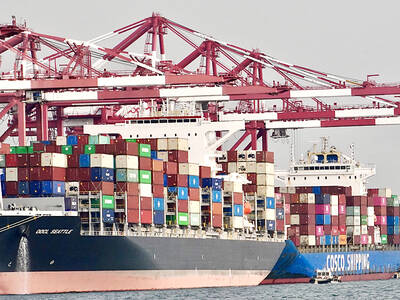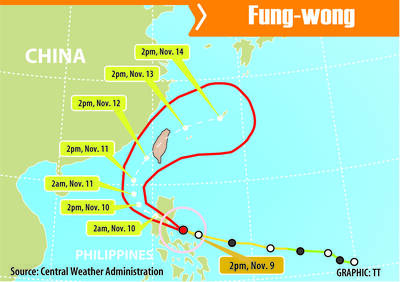The Presidential Office yesterday condemned continued Chinese military activity around Taiwan, after 28 People’s Liberation Army (PLA) aircraft crossed the median line of the Taiwan Strait within 24 hours.
From 6am on Sunday to 6am yesterday, the PLA deployed 57 aircraft and four navy vessels near Taiwan, the Ministry of National Defense said.
Twenty-eight of the aircraft crossed the median line of the Strait and entered the nation’s southwest air defense identification zone.

Photo: Taiwan Ministry of Defense via AP
They included two Sukhoi Su-30 fighter jets, 12 J-16 multipurpose fighters, two J-10 jets and two BZK-005 uncrewed aerial vehicles (UAVs), a ministry map showed.
There were also two nuclear-capable H-6 bombers and one BZK-005 UAV that flew around Taiwan into southeastern airspace before turning back.
The PLA’s Eastern Theater Command in a statement described the actions as “joint combat readiness patrols and actual combat drills.”
It was the PLA’s second major incursion within a month, after it on Dec. 25 and Dec. 26 deployed 71 aircraft around Taiwan — 47 of which crossed the median line — as well as seven warships.
Presidential Office spokesman Xavier Chang (張惇涵) responded to the activity with “strong condemnation.”
He also reiterated that Taiwan’s well-established stance is to avoid escalation and refrain from provoking disputes.
Beijing uses any kind of baseless charge to continue its military activity around Taiwan, Chang said, adding that peace and stability in the Strait is the joint responsibility of both sides.
However, the nation would resolutely defend its sovereignty and security, and protect democracy and freedom, he said.
The ministry in a statement said that it uses aircraft, ships and shore-based missile systems to closely monitor and respond to PLA activity.
Military personnel are also trained for war preparedness based on the principle of no escalation and no provocation, it said.
These latest drills were likely intended to intimidate the US against implementing Taiwan-friendly sections of a recently passed defense spending bill, said Chieh Chung (揭仲), an associate research fellow at the National Policy Foundation think tank.
US President Joe Biden last month signed into law the National Defense Authorization Act for Fiscal Year 2023, which includes up to US$10 billion in security assistance to Taiwan over five years and fast-tracked weapons procurement.
Recent PLA exercises have been relatively insignificant in military terms, Chieh said.
In Sunday’s exercises and those on Friday and Dec. 31, the PLA craft turned back shortly after crossing the median line, showing that the moves are intended to exert political pressure, he said.
The exercises likely serve to remind Washington that if it fails to seriously consider Beijing’s stance on cross-strait matters, there can be no effective “guardrails” against conflict, Chieh said.
At the same time, Beijing is seeking to normalize incursions across the Strait’s median line, which until August last year was tacitly accepted as a demarcator and rarely crossed, Chieh said.
By eroding Taiwan’s defensive space, Beijing is seeking to minimize its early-warning time, he said.
The two H-6 bombers and accompanying UAV traveling into airspace southeast of Taiwan appeared to be a practice run for long-distance joint combat capabilities under the direction of a KJ-500 airborne early warning and control plane stationed inside Taiwan’s southwest air defense identification zone, he said.
Chieh said that the PLA is likely to continue sending long-distance UAVs to conduct reconnaissance for strike fleets, and potentially serve as a guide for long-distance precision ammunition.

The Central Weather Administration (CWA) yesterday said it expected to issue a sea warning for Typhoon Fung-Wong tomorrow, which it said would possibly make landfall near central Taiwan. As of 2am yesterday, Fung-Wong was about 1,760km southeast of Oluanpi (鵝鑾鼻), Taiwan’s southernmost point, moving west-northwest at 26kph. It is forecast to reach Luzon in the northern Philippines by tomorrow, the CWA said. After entering the South China Sea, Typhoon Fung-Wong is likely to turn northward toward Taiwan, CWA forecaster Chang Chun-yao (張峻堯) said, adding that it would likely make landfall near central Taiwan. The CWA expects to issue a land

Taiwan’s exports soared to an all-time high of US$61.8 billion last month, surging 49.7 percent from a year earlier, as the global frenzy for artificial intelligence (AI) applications and new consumer electronics powered shipments of high-tech goods, the Ministry of Finance said yesterday. It was the first time exports had exceeded the US$60 billion mark, fueled by the global boom in AI development that has significantly boosted Taiwanese companies across the international supply chain, Department of Statistics Director-General Beatrice Tsai (蔡美娜) told a media briefing. “There is a consensus among major AI players that the upcycle is still in its early stage,”

The Central Weather Administration (CWA) yesterday said it is expected to issue a sea warning for Typhoon Fung-wong this afternoon and a land warning tomorrow. As of 1pm, the storm was about 1,070km southeast of Oluanpi (鵝鑾鼻), Taiwan’s southernmost point, and was moving west-northwest at 28 to 32kph, according to CWA data. The storm had a radius of 250km, with maximum sustained winds of 173kph and gusts reaching 209kph, the CWA added. The storm is forecast to pass near Luzon in the Philippines before entering the South China Sea and potentially turning northward toward Taiwan, the CWA said. CWA forecaster Chang Chun-yao (張峻堯) said

‘SECRETS’: While saying China would not attack during his presidency, Donald Trump declined to say how Washington would respond if Beijing were to take military action US President Donald Trump said that China would not take military action against Taiwan while he is president, as the Chinese leaders “know the consequences.” Trump made the statement during an interview on CBS’ 60 Minutes program that aired on Sunday, a few days after his meeting with Chinese President Xi Jinping (習近平) in South Korea. “He [Xi] has openly said, and his people have openly said at meetings, ‘we would never do anything while President Trump is president,’ because they know the consequences,” Trump said in the interview. However, he repeatedly declined to say exactly how Washington would respond in